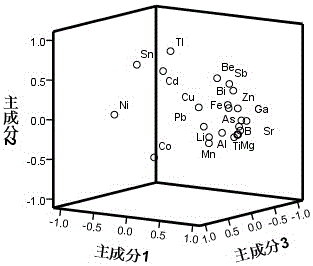Method for distinguishing geographical indications of rice
A technology for geographical indications and rice, applied in the field of distinguishing geographical indications of rice, can solve the problems of unstable odor indicators, low discrimination precision, and great influence on results, and achieve stable mineral element fingerprint characteristics, fast analysis speed, and stable fingerprint characteristics. Effect
- Summary
- Abstract
- Description
- Claims
- Application Information
AI Technical Summary
Problems solved by technology
Method used
Image
Examples
Embodiment 1
[0019] Embodiment 1: the determination of the pretreatment of sample and relevant element content
[0020] Samples were collected from farmers’ paddy fields in Sheyang County, Jiangsu Province, Wuchang City and Panjin City, Heilongjiang Province. Each sample was 1.0kg. A total of 54 rice samples were collected, including 19 samples in Sheyang County, Jiangsu Province, 15 samples in Wuchang City, Heilongjiang Province, and Panjin City. For 20 parts, the collected rice was hulled, milled, pulverized with a pulverizer for 30 seconds, and passed through a 250-mesh sieve for testing.
[0021] The 7700x ICP-MS produced by Agilent was used to detect the contents of the 24 kinds of mineral elements to be measured in the above rice samples from different origins. Weigh 0.5g of the above samples into the digestion tube respectively, add 7ml of high-grade pure concentrated nitric acid, after microwave digestion, use 2% nitric acid (high-grade pure) to dilute the digestion solution to a 1...
Embodiment 2
[0025] Example 2: Feasibility analysis of ICP-MS technology for rice origin identification
[0026] ICP-MS is used to characterize the fingerprint information of the 24 mineral elements in the sample. The amount of data information is large, and it is necessary to combine chemometric analysis methods to select effective information. The principle of principal component analysis is a statistical method that converts multiple interrelated numerical indicators into a few unrelated comprehensive indicators, that is, uses fewer indicators to replace and comprehensively reflect the original more information.
[0027] Use the software SPSS16.0 to conduct principal component analysis on the measured data, and perform PCA analysis based on the contents of the 24 mineral elements to be measured, such as figure 1 Shown is the loading diagram of the first three principal components. The first principal component mainly synthesizes B, Mg, Ti, V, Cr, Ga, Sr, Ba, Al, Mn, Fe, Ni, Zn, As, Sb, ...
Embodiment 3
[0028] Embodiment 3: stepwise discriminant analysis method establishes discriminant model
[0029] Discriminant analysis is to classify the researched object according to some observed indicators, obtain the so-called discriminant function, and then use the discriminant function to classify the samples of unknown classification.
[0030] From the results of principal component analysis, it can be seen that ICP-MS mineral element fingerprint analysis technology is feasible to identify the origin of rice. In order to further understand the results of mineral elements on the discrimination of rice origin, a step-by-step discriminant analysis was carried out on the mass concentrations of 24 mineral elements described in different types of samples, and variables that were effective for regional discrimination were screened out, unnecessary variables were eliminated, and a discriminant model was established. Cross-validation was performed to further confirm the reliability of the mo...
PUM
 Login to View More
Login to View More Abstract
Description
Claims
Application Information
 Login to View More
Login to View More - R&D
- Intellectual Property
- Life Sciences
- Materials
- Tech Scout
- Unparalleled Data Quality
- Higher Quality Content
- 60% Fewer Hallucinations
Browse by: Latest US Patents, China's latest patents, Technical Efficacy Thesaurus, Application Domain, Technology Topic, Popular Technical Reports.
© 2025 PatSnap. All rights reserved.Legal|Privacy policy|Modern Slavery Act Transparency Statement|Sitemap|About US| Contact US: help@patsnap.com



